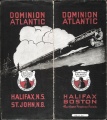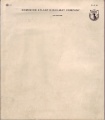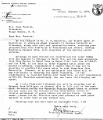Dominion Atlantic Railway Digital Preservation Initiative - Wiki
Use of this site is subject to our Terms & Conditions.
Difference between revisions of "Category:Logos"
| Line 3: | Line 3: | ||
==1st DAR Herald ~1895 - ~1919== | ==1st DAR Herald ~1895 - ~1919== | ||
| − | The circular D.A.R. herald used on both locomotive number plates and on steamships is a copy of the British [https://en.wikipedia.org/wiki/Order_of_the_Garter Order of the Garter] arms topped with a [https://commons.wikimedia.org/wiki/File:Crown_of_Saint_Edward_(Heraldry).svg St. Edwards crown] that denotes The Sovereign. Originally an honour bestowed by The Sovereign on fellow royalty and gentry, in | + | The circular D.A.R. herald used on both locomotive number plates and on steamships is a copy of the British [https://en.wikipedia.org/wiki/Order_of_the_Garter Order of the Garter] arms topped with a [https://commons.wikimedia.org/wiki/File:Crown_of_Saint_Edward_(Heraldry).svg St. Edwards crown] that denotes The Sovereign. Undeniably, the link between the D.A.R. and royalty was further cemented with the naming of 5 of the Prince class of steamships. There are two individuals under research at this moment that were knighted and may explain the use of the British arms. |
| + | |||
| + | As a side note, Knighthood is a rather complicated system of award that has changed over the years. Originally an honour bestowed by The Sovereign on fellow royalty and gentry, since the creation of the Order of the British Empire by King George V in 1917 it has been bestowed in 5 levels, GBE-Knight Grand Cross, KBE-Knight Commander, CBE-Commander, OBE-Officer and MBE-Member on persons that are awarded for some kind of achievement in science, art or public service. Only a GBE and a KBE can user the title Sir however. In addition, Knight Bachelor may be awarded as well and at the same time as the order of the British Empire which allows the title of Sir | ||
| + | to be used. | ||
The circular locomotive number plates seemed to appear in 1894 with the formation of the D.A.R railway and steamship lines but were only used up to [[DAR0043|No 43]] (observed) and the steamship line circular herald appeared to disappear with the steamship lines sale of its Yarmouth connections when the C.P.R. leased the line in 1911. | The circular locomotive number plates seemed to appear in 1894 with the formation of the D.A.R railway and steamship lines but were only used up to [[DAR0043|No 43]] (observed) and the steamship line circular herald appeared to disappear with the steamship lines sale of its Yarmouth connections when the C.P.R. leased the line in 1911. | ||
Revision as of 02:40, 27 May 2020
Logos & Heralds
1st DAR Herald ~1895 - ~1919
The circular D.A.R. herald used on both locomotive number plates and on steamships is a copy of the British Order of the Garter arms topped with a St. Edwards crown that denotes The Sovereign. Undeniably, the link between the D.A.R. and royalty was further cemented with the naming of 5 of the Prince class of steamships. There are two individuals under research at this moment that were knighted and may explain the use of the British arms.
As a side note, Knighthood is a rather complicated system of award that has changed over the years. Originally an honour bestowed by The Sovereign on fellow royalty and gentry, since the creation of the Order of the British Empire by King George V in 1917 it has been bestowed in 5 levels, GBE-Knight Grand Cross, KBE-Knight Commander, CBE-Commander, OBE-Officer and MBE-Member on persons that are awarded for some kind of achievement in science, art or public service. Only a GBE and a KBE can user the title Sir however. In addition, Knight Bachelor may be awarded as well and at the same time as the order of the British Empire which allows the title of Sir
to be used.
The circular locomotive number plates seemed to appear in 1894 with the formation of the D.A.R railway and steamship lines but were only used up to No 43 (observed) and the steamship line circular herald appeared to disappear with the steamship lines sale of its Yarmouth connections when the C.P.R. leased the line in 1911.
There appears to also have been more than one version of the circular herald as well. As you can see from the photo below taken on the poop deck of one of the DAR's ships, this version has a single coat of arms in the centre differing from the 2 coats of arms in the centre found in publications at that time. Some heralds as well dropped the tip of the belt from the bottom of the circle as seen on the early publications and the hand made flags.
Perhaps as more images come to light we will be able to better discern what each version's time period and use was.
The Captain and his officers on what could be the fan tail of the SS Prince Rupert.
2nd DAR (Evangeline) Herald ~1919 - ~1937
Replacing The Order of the Garter coat of arms style in it's advertising, this logo capitalized on the railway's successful marketing of Evangeline but still retained the circular form. A simplified version soon showed up only a few years later on the tenders of locomotives extending the Evangeline imagery to the railway's rolling stock.
3rd DAR (Evangeline) Herald ~1937 - ~1967
The third Dominion Atlantic herald observed is present in publications, stationary and timetables starting in the mid-nineteen thirties. An obvious progression of the popular tender herald, it became the imagery that defined the Evangeline line to generations of travelers.
The first page of Mrs. Fenwick's Itinerary from 1956 showing the 1st Evangeline Herald.
4th DAR (Evangeline) Herald ~1937 - ~1946
The fourth and alternative Dominion Atlantic herald observed only on promotional publications started in the mid-nineteen thirties. It was a more detailed logo that did not seem to find a place, except for a few promotional booklets, on the tenders and stationary of the railway. A colourized version by this website, taken from the 1936 brochure, is our choice for the DAR DPI site logo.
Tender and Rolling Stock DAR (Evangeline) Herald ~1927 - 1959
Interestingly enough, tender and rolling stock heralds were unique to themselves. The heralds were not apparently used on anything else yet their lineage from the second DAR corporate herald is obvious.
First appearing sometime around between 1924 and 1927 (No. 45 (as so far observed) the herald was used through to the end of steam in 1959 on select tenders and rolling stock. Some minor variations have been observed throughout the years and as our herald photo collection grows we may be able to better identify what those differences were and what years they spanned. Passenger car use of the Evangeline herald in also covered in more detail in the colours section.
It is also known that for some period of time, Evangeline always faced forward. This would mean of course that the outer circle and lettering reamined the same but the centre Evangeline would be mirror images of each other from side to side.
Gallery
Pontgravé, locomotive No. 25 after 1923.
No. 26 "Kent" June 18, 1936 at Kentville
Herald used on the business car Nova Scotia in August 1949.
Inspection car M-107, a 1938 MacLaughlin Buick Limosine, beside the roundhouse in Kentville on July 3, 1954.
Tender from No. 2551.
Tender herald from No. 1046 on August 27, 1956.
Pages in category "Logos"
The following 2 pages are in this category, out of 2 total.




















